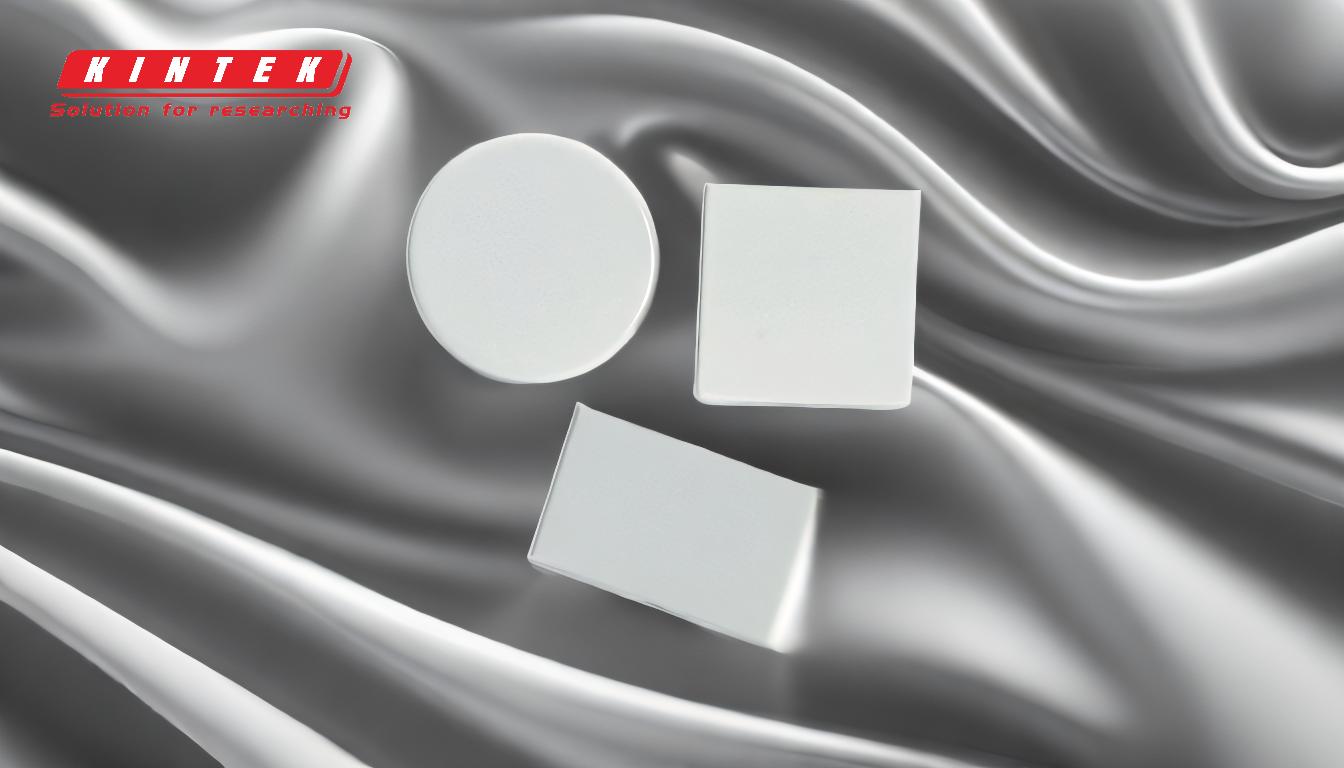簡潔に言えば、臭化カリウム(KBr)がIR分光法に用いられるのは、赤外光に対して透明であり、固体でガラスのようなペレットに圧縮できるためです。これにより、通常は不透明な固体試料を、光が透過して分析できるように分光計の光路内に保持することができます。
KBrの主要な機能は、固体状の「溶媒」として機能することです。これは、試料を懸濁させる光学的に透明で干渉しないマトリックスを作成し、簡単に溶解または融解できない固体材料の赤外スペクトルを測定することを可能にします。
KBrのユニークな特性
赤外領域における透明性
KBrの最も重要な特性は、中赤外領域(通常4000~400 cm⁻¹)での吸収がないことです。
KBr自体はこの光を吸収しないため、クリーンなバックグラウンドを提供します。最終スペクトルに見られる吸収ピークは、KBrマトリックスではなく、試料に起因するものと自信を持って断定できます。
圧力下での可塑性
KBrはアルカリハライドであり、塑性変形を示す塩の一種です。数トンの圧力を加えると、結晶性のKBr粉末が流動し、単一の透明なガラス状のディスクに融合します。
このプロセスにより、細かく粉砕された試料粒子が新しく形成されたKBrシート内に物理的に閉じ込められ、分析のために所定の位置に保持されます。
化学的に不活性なマトリックス
ほとんどの有機化合物および多くの無機化合物にとって、KBrは化学的に不活性です。調製中または測定中に試料と反応することはありません。
これにより、得られるスペクトルが元の試料を表すものであり、マトリックスとの反応によって形成された新しい化合物のものではないことが保証されます。

KBrペレット法の解説
ステップ1:混合と粉砕
ごく少量の固体試料(通常1~2 mg)を、はるかに多量の高純度乾燥KBr粉末(約100~200 mg)に加えます。
この混合物をめのう乳鉢と乳棒で徹底的に粉砕します。目標は、光散乱を最小限に抑えるために、試料の粒子サイズをIR光の波長よりも小さくすることです。
ステップ2:ペレットの圧縮
細かく粉砕された粉末を専用のダイに入れます。ダイは、閉じ込められた空気、そしてより重要なことに、大気中の水分を除去するために真空下に置かれることがよくあります。
次に、油圧プレスを使用してダイに莫大な圧力(8~10トン)を加え、粉末を圧縮してKBrを融合させて透明なペレットを形成します。
ステップ3:バックグラウンド補正
試料を測定する前または後に、純粋なKBrで作られたペレットを使用して「ブランク」スペクトルを記録することがよくあります。これにより、機器のソフトウェアが残留水分や機器のアーティファクトによるわずかな吸収を差し引き、よりクリーンな試料スペクトルが得られます。
トレードオフと落とし穴の理解
水分の問題
KBrは吸湿性であり、大気中の水分を容易に吸収します。これはKBr法を使用する際の最も一般的な問題です。
水は非常に強く幅広いIR吸収帯(約3400 cm⁻¹に広いピーク、約1640 cm⁻¹に別のピーク)を持っています。KBrが「湿っている」場合、これらの大きな水のピークが実際の試料からの重要なピークを完全に覆い隠してしまう可能性があります。乾燥したKBrを使用し、空気への露出を最小限に抑えることが重要です。
光散乱効果
試料が十分に細かく粉砕されていない場合、その粒子は赤外光を吸収するだけでなく散乱させてしまいます。これにより、ベースラインが傾斜し、ピークが不明瞭な歪んだスペクトルが得られます(これはクリスチャンセン効果として知られる問題です)。
試料変化の可能性
ペレットを形成するために使用される高圧は、試料の結晶構造に相変化(多形)を誘発することがあります。これは、測定したスペクトルが開始時と同じ正確な結晶形のものではない可能性があることを意味します。
不均一な分布
試料がKBrと十分に混合されていない場合、その濃度はペレット全体で均一ではありません。これは不正確で再現性のない結果につながる可能性があり、定量分析にとって重大な問題となります。
分析に適した選択をする
ペレット作成プロセスを簡単に準備することで、試料を正確に反映する高品質のスペクトルが得られます。
- 主な焦点が単純な化合物同定である場合:骨まで乾燥したKBrを使用し、試料を徹底的に粉砕して、水分や散乱アーティファクトのないクリーンで明確なピークを得ることを優先します。
- 主な焦点が定量測定である場合:試料とKBrの綿密な計量と、完全に均一な混合物の確保は、再現性のある結果を達成するために不可欠です。
- 感圧性の材料を分析している場合:高圧を必要としないミネラルオイルに試料を粉砕するヌジョールマル法など、代替の固体サンプリング方法を検討してください。
最終的に、KBrペレット技術を習得することは、多種多様な固体材料の分子構造を強力かつ確実に解明する窓を提供します。
要約表:
| 特性 | IR分光法における利点 |
|---|---|
| IR透明性 | 干渉する吸収ピークのないクリーンなバックグラウンドを提供します。 |
| 圧力下での可塑性 | 試料を保持する透明なペレットに融合します。 |
| 化学的不活性 | ほとんどの試料と反応せず、その完全性を保ちます。 |
KINTEKで正確で信頼性の高いIR分析を実現しましょう。
KBrペレット技術を習得することは、正確な固体試料の同定に不可欠です。KINTEKは、高純度のKBr粉末、耐久性のあるペレットダイ、信頼性の高い油圧プレスを提供することに特化しており、試料調製の一貫性と汚染のない状態を保証します。
当社のラボ機器と消耗品は、吸湿や光散乱などの一般的な課題を克服し、常に明確で解釈可能なスペクトルを提供できるよう設計されています。
今すぐKINTEKにお問い合わせください。お客様のラボの特定のニーズについてご相談いただき、当社の専門家がIR分光法ワークフローの最適化をお手伝いします。
関連製品
- KBR ペレットプレス 2T
- 割れた電気実験室の餌出版物 40T/65T/100T/150T/200T
- 自動ラボ XRF & KBR ペレットプレス 30T / 40T / 60T
- 自動実験室の餌の出版物機械 20T/30T/40T/60T/100T
- FTIR のための型を押す XRF 及び KBR の鋼鉄リング実験室の粉の餌



















